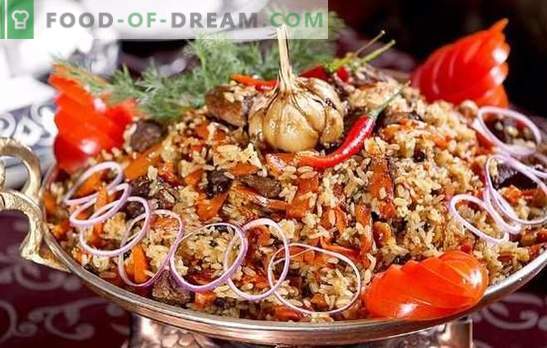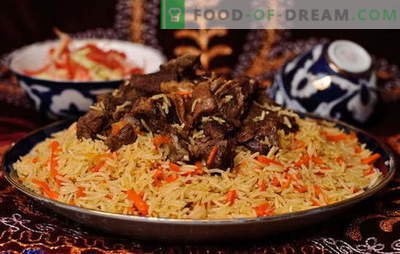
Pilaf is a familiar dish with a huge number of recipes. With nothing they cook it! All over the world they love fragrant and crumbly Uzbek pilaf. But the pilaf from Azerbaijan is not inferior to him in the taste. Is there any difference between these dishes?
Rice for Azerbaijani pilaf
Only Azerbaijani pilaf involves pre-cooking rice in a separate container. Uzbeks would come from such technology in obvious shock, they would consider it a huge mistake. They cook rice together with zirvak (a mixture of meat with vegetables, spices, broth). But Azerbaijanis are confident in their technology, because it allows you to get an incredibly tasty and fragrant dish.
Features of cooking rice:
- The grass is washed several times before use until the water is clear.
- If uncleaned varieties are used, it is also soaked before cooking for at least an hour. Salt is added to the water so that the rice does not crack and retains its shape.
- Pakistani rice, such as Basmati, does not require soaking; it is enough to wash it thoroughly.
- Washed or soaked rice is poured into a saucepan with water, boiled until half cooked. Liquids take a lot, you do not need to count. The time depends on the variety used. To absolute softness does not need to bring.
- Boiled rice is sent to a colander, washed with running water, mixed with oil and spices, brought to full readiness.
Very often, apart from cooking rice, a special flat cake or dough layer participates in Azerbaijani pilaf. It is called “Kazmag”. It is not present in all recipes, sometimes replaced by potatoes or other vegetables.
Rice in Uzbek Pilau
Uzbek pilaf is cooked with different varieties of rice, but large cereal is chosen. It is never cooked separately, it is considered a blunder. Features of preparation:
- The rice is washed with cold water until the liquid is completely clear. It is believed that you need to pour and drain the water seven times.
- Sometimes rice is soaked or scalded with boiling water, it depends on the recipe and variety.
- The amount of water is strictly observed. Liquid is measured by level, it usually covers products with two fingers. If the cauldron is of a non-standard size, then proportions of 1: 2 or 1: 1.7 are used.
- Rice with meat in a cauldron is never stirred. This is done only with a ready dish.
Crumbling is appreciated in both Uzbek and Azerbaijani pilaf. These dishes are very similar. If you take a handful of rice and squeeze it in your hand, it should not stick together.
Azerbaijani stuffing is something
In addition to the method of cooking rice, Azerbaijani plov is different from the Uzbek fellow stuffing. This is not always beef or lamb, although you can also make a famous dish with them. In the Azerbaijani cuisine there are very unusual and original solutions.
What is added to Azerbaijani plov:
- different birds, including game;
- dried fruits;
- nuts;
- pumpkin;
- smoked or fresh fish.
Often mix different products. Of course, there are vegetables in the dish. Carrots are not in such esteem, as in other types of pilaf, it is often not used at all. Garlic, laurel, various spices will be useful in Azerbaijani pilaf, and greens are surely added in large quantities. But the important ingredient is dressing butter.
By the way, Azerbaijani pilaf is usually cooked at home, it is an everyday dish. It is rarely seen in restaurants. If they order it there, it’s mostly tourists. Uzbek plov is a festive dish, without which many celebrations cannot do.
Classical Azerbaijani plov with lamb
Since Uzbek pilaf is cooked with lamb, for comparison, the recipe of this dish is made using Azerbaijani technology. In addition to meat and rice, potatoes are used, and dried fruit will also be needed. But these are not the only differences.
Ingredients
- 1 kg of mutton;
- 2 cups long rice;
- 6 bulbs;
- 80 g of greens;
- 4 potatoes;
- olive oil;
- 100 g raisins;
- 100 g dried apricots;
- turmeric, thyme;
- 150 g butter.
Method of preparation
- Wash rice, pour into boiling salted water, stir. Boil after boiling for 7-8 minutes, try. It should remain slightly firm. Drain in a colander, rinse.
- Peel the potatoes, cut them large and put them in the bottom of the pan. Vegetable will not let plov burn. We try to fill all the voids.
- Pour half of the rice on the potatoes, pour 70 grams of melted butter. Pour the remaining rice, add the rest of the oil, sprinkle with turmeric, cover. Boil an hour at minimum heat.
- Fry diced lamb in olive oil. Meat shift to another dish. In this pan, pour 0.5 cups of boiling water, stir and pour all to the meat.
- Cut the onion into half rings, send to the lamb. Add herbs, spices, stir and simmer for 40 minutes.
- Wash dried fruits, add to almost finished meat. Dried apricots can be cut or left in this form. Salt more if needed. Stew with meat for another half an hour.
- We spread rice on plates, then cooked lamb with dried fruits on top, serve to the table.
Here, rice is cooked to the end separately, but sometimes it is poured out for meat, allowed to stew for a while together.
Classical Uzbek plov
Many people know this recipe. Still, Uzbek plov is known all over the world. In the classic version, it is made lamb and fat tail.
Ingredients
- 1 kg of mutton;
- 0.2 kg fat tail;
- 3 heads of garlic;
- 5 onions;
- 5 carrots;
- 1 kg of rice;
- Zira, saffron and other spices.
Method of preparation
- Dice lard, fry, bacon, throw away. Fall asleep in fat onion, cut into half rings. Cook until ruddy color and enter the lamb. Fry a few minutes with meat.
- Cut the carrot into strips; in no case do we use a grater. Add to the meat with onions. Give a little to fry, add spices, well salt, pour boiling water. Stew for at least an hour. Ideally, we bring the lamb to soft.
- Wash rice several times. From the heads of garlic we remove the top layer of the husk; there is no need to clean and separate the cloves.
- Pour the rice into the zirvak, stick the heads of garlic and pour boiling water over it so that the water covers the products on two fingers.
- Cover cauldron and weave pilaf for 30-40 minutes. Then give him the same amount of time.
As you can see, the dishes are really prepared in different ways, they have their zest (sometimes in the literal meaning of the word), but the result is happy in any case. Fragrant and crumbly pilaf can be tasted in Uzbekistan and Azerbaijan.






















